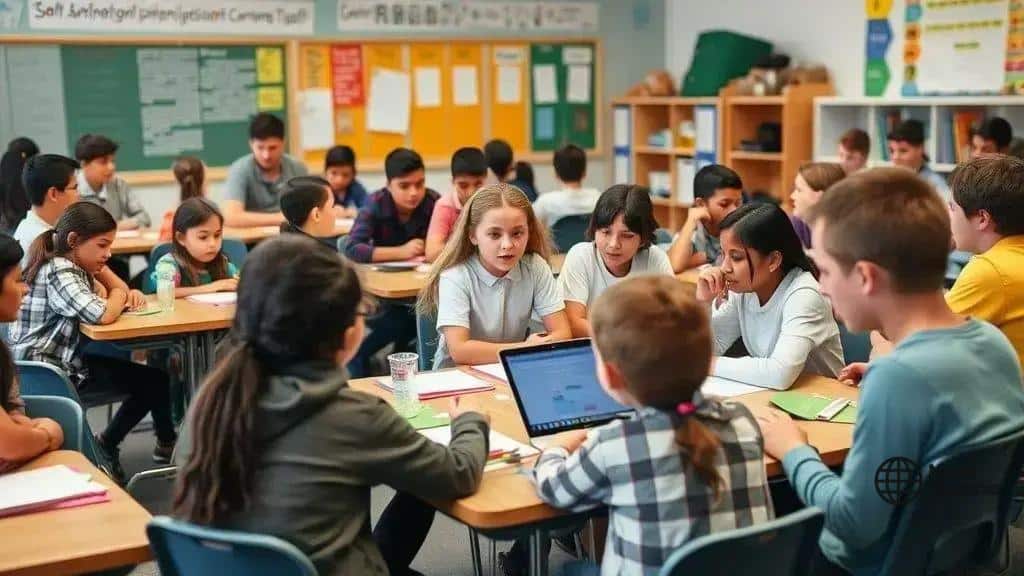Neurodiversity in the classroom: embrace diverse learning

Neurodiversity in the classroom emphasizes recognizing and embracing different learning styles to create an inclusive environment that supports all students, enhancing their engagement and success.
Neurodiversity in the classroom is an essential concept that encourages us to appreciate the wide range of learning styles students bring. Have you ever wondered how different approaches could transform your teaching? Let’s explore how we can embrace these differences for a better learning experience.
Understanding neurodiversity: What does it mean?
Understanding neurodiversity is crucial in today’s education. It refers to the concept that variations in the human brain, particularly in how we think and learn, are naturally occurring. Each student brings a unique set of strengths and challenges to the classroom.
This diversity allows a wider range of perspectives and problem-solving approaches. Recognizing these differences means embracing them within our teaching methods.
Key Aspects of Neurodiversity
It’s important to highlight that neurodiversity includes conditions like autism, ADHD, dyslexia, and more. Each of these brings specific ways of learning and interacting with the world. Understanding these can help teachers cater to individual needs effectively.
- Valuable perspectives: Neurodiverse students often approach problems in creative ways.
- Social connections: Collaboration among diverse learners promotes empathy and understanding.
- Targeted support: Educators can provide tailored strategies that align with individual learning styles.
By embracing neurodiversity, educators can create a more inclusive classroom environment. For instance, using varied teaching methods—such as visual aids, hands-on activities, and technology—can address multiple learning preferences. This approach ensures every student has the opportunity to succeed.
Understanding the science behind neurodiversity helps us appreciate how each brain works differently. Educators can leverage this knowledge to foster an enriching and supportive learning environment.
The benefits of embracing different learning styles
Embracing different learning styles in the classroom can significantly enhance the educational experience for all students. When teachers acknowledge and adapt to individual learning preferences, they create an environment that fosters growth and engagement. This approach leads to numerous benefits for both students and educators.
Enhanced Engagement
When students learn in ways that resonate with them, their motivation increases. Engaging lessons that incorporate various teaching methods not only captivate learners but also make the material more relatable. This connection encourages students to actively participate, resulting in a more dynamic classroom environment.
- Increased participation: Students are more likely to engage in discussions and activities.
- Better retention: By using multiple approaches, learners can remember information more effectively.
- Improved confidence: Mastering concepts in their preferred style boosts student self-esteem.
Another key advantage is that recognizing learning styles helps to accommodate diverse needs. For example, visual learners benefit from diagrams and charts, while auditory learners thrive with discussions and lectures. Tailoring instruction to suit various styles ensures that each student can reach their full potential.
Moreover, embracing these differences promotes inclusivity and respect among classmates. When students understand each other’s unique strengths and challenges, they learn to support one another. This sense of community enriches the learning experience and creates a positive classroom atmosphere.
In summary, adapting to different learning styles not only enhances individual success but also contributes to a more collaborative and respectful environment. This holistic approach prepares students for future challenges by equipping them with a broader range of skills.
Practical strategies for diverse classrooms

Implementing practical strategies in diverse classrooms can greatly enhance the learning experience for all students. By adapting teaching methods to suit various learning styles, educators can ensure that every student feels included and empowered.
Use Multiple Teaching Methods
One of the most effective ways to address diverse needs is to employ a variety of teaching methods. This can include visual aids, hands-on activities, group work, and technology integration. When students have access to multiple ways of understanding content, they are more likely to grasp complex concepts.
- Visual aids: Charts and diagrams can help learners who understand information better through sight.
- Hands-on activities: Practical applications allow students to experience concepts in action.
- Group work: Collaboration fosters communication and helps students learn from each other.
Another important strategy is to differentiate instruction by tailoring lessons to various skill levels. This involves creating different tasks or questions based on students’ abilities. By doing so, teachers can challenge advanced learners while also offering support to those who may be struggling.
Moreover, fostering a positive classroom culture plays a key role in supporting diverse learners. Creating an environment where students feel safe to express themselves and ask questions can lead to greater engagement. Encourage students to share their experiences and backgrounds, as this can enrich classroom discussions and promote understanding among peers.
Finally, it’s essential to involve parents and the community in the learning process. Keeping an open line of communication ensures that educators understand the diverse backgrounds of their students. This collaboration can help to reinforce learning at home and provide additional resources.
Creating an inclusive environment for all learners
Creating an inclusive environment for all learners is essential in today’s classrooms. An inclusive setting ensures that every student feels valued, respected, and supported in their educational journey. This approach not only enhances learning but also promotes social interaction and cooperation.
Establishing a Welcoming Atmosphere
To foster inclusivity, it’s important to establish a welcoming atmosphere. This can be achieved by using positive language, and encouraging interactions among students. Teachers can set the tone on the first day of school by introducing activities that promote teamwork and respect.
- Encourage respect: Classroom rules should emphasize kindness and understanding.
- Diverse decorations: Display posters and materials that reflect different cultures and identities.
- Inclusive language: Use language that acknowledges and respects individual differences.
Using various teaching strategies is another vital element in creating an inclusive classroom. This means adapting lessons to accommodate different learning styles and abilities. For instance, incorporating visual, auditory, and kinesthetic activities can engage all students.
Additionally, allowing choices in how to complete assignments can empower students. When learners can select their preferred methods or subjects, they are more likely to feel in control and invested in their education. Providing options also helps in acknowledging their individual strengths.
Engaging families and the community can further enhance inclusivity. Inviting parents to share their experiences and perspectives fosters connections among students from different backgrounds. This collaboration creates a supportive network that benefits everyone involved in the learning process.
Engaging parents and the community in support
Engaging parents and the community in support of education is vital for fostering a thriving learning environment. When families are involved, students tend to perform better and feel more connected to their schools. Communication between educators, parents, and community members can create a network of support that benefits everyone.
Building Strong Relationships
Developing strong relationships with parents starts with open communication. Teachers should provide regular updates on student progress and classroom activities. This transparency helps parents feel informed and engaged in their child’s education.
- Regular newsletters: Share important information about classroom events and learning goals.
- Parent-teacher conferences: Schedule meetings to discuss student progress and address concerns.
- Social media updates: Utilize platforms like Facebook or school websites to keep families engaged.
Involving the community can take many forms. Schools can partner with local businesses and organizations to create programs that benefit students. For example, mentorship programs can connect students with professionals in their fields of interest.
Another strategy is to host events that invite family participation, such as workshops, literacy nights, or cultural celebrations. These events not only educate parents but also strengthen the school’s community ties. When parents feel welcome and engaged, they are more likely to support their children’s education actively.
Creating volunteer opportunities within the school can also enhance community involvement. Parents and local residents can assist in classrooms, help with events, or contribute to extracurricular activities. This engagement fosters a sense of ownership and pride in the school.
In summary, embracing neurodiversity in the classroom fosters an inclusive learning environment where all students can thrive. By understanding different learning styles, employing practical strategies, and engaging parents and the community, we create a supportive atmosphere that encourages participation and growth. The benefits of inclusivity are significant, enhancing not only student outcomes but also the overall classroom experience. With collaboration from educators, families, and the community, we can ensure every learner’s needs are met and their potential realized.
FAQ – Questions about Neurodiversity and Inclusive Education
What is neurodiversity?
Neurodiversity refers to the concept that various neurological conditions, such as autism and ADHD, represent natural variations of the human brain and its functioning. It emphasizes the strengths and abilities of individuals rather than their challenges.
How can I support different learning styles in my classroom?
You can support different learning styles by incorporating various teaching methods, such as visual aids, hands-on activities, and group work. This approach allows all students to engage with the material in ways that resonate with them.
Why is parental involvement important in education?
Parental involvement enhances student performance and motivation. When parents are engaged, they provide additional support, reinforce learning at home, and foster a sense of community within the school.
What are some strategies to create an inclusive classroom?
To create an inclusive classroom, establish a welcoming environment, use diverse teaching methods, encourage collaboration, and involve parents and the community. These strategies help ensure that every student feels valued and supported.





